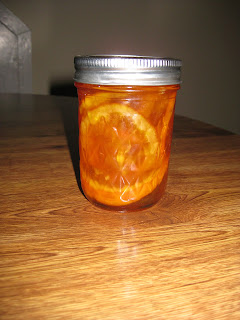I ordered everything I could think of to start my jam project, including two different pots (a copper preserving pan and a stainless steel canning pot), and simple supplies like a magnet wand, hot-jar gripper and stainless steel funnel. When the Mauviel copper preserving pan arrived in the mail, I was taken by its simplicity and stunning beauty. Oh, and heavy!
I've been leafing through canning books from the library for a couple of weeks now, taking home about 10 of them. I opted to start my adventures with recipes from Christine Ferber, a master jammer from France who wrote a jam cookbook called Mes Confitures. She's garnered heaps of kudos, so I thought she'd be a good teacher to start with.
It being winter and citrus season here in California, I scouted the weekly Farmer's Market in Santa Rosa for good-looking citrus. I found lovely Seville oranges, which I know are classic marmalade oranges. So, with great excitement, I decided my first marmalade would be Christine Ferber's Bitter Orange.
First off, Ms. Ferber does not use commercial pectin. I like this -- natural (and organic) works best for me. What she does use instead is the pectin in apples to gel her jams. So the first day, I cut Granny Smith apples into quarters, but they looked so big I sliced them down into eighths. I added water and heated them in my big stainless steel skillet for half an hour. They were mushy at this point. I poured them over a sieve, collecting the juice (lots of pectin) in a bowl below.
The next day I squeezed four pounds of Seville oranges, first picking out the seeds with a fork over a bowl to save the juice. Let me say this -- Seville oranges are loaded with seeds.
These seeds went into a muslin jelly bag (they are going to disgorge even more pectin than just that apple juice). I took a quick sip of the Seville orange juice -- extremely sour and puckery, undrinkable, actually. Then I sliced two navel oranges very thinly. I started off cooking these slices with sugar and water in the copper preserving pan, boiling until translucent. What a gorgeous sight, and tasty too.
Once that was done I added the really sour Seville orange juice, the tart apple juice, juice from a lemon, along with sugar that I heated up in a 225 oven. Oh, and the orange seeds in the muslin bag. All this cooked away, frothing initially, then bubbling..
Here's where I started getting flustered. I popped a dozen jars into the 225 oven. I dropped the lids in some hot water on the stove. When it suddenly looked like the orange concoction might be jelling, I scooped some on a spoon I had stashed in the freezer, returned it to the cold, and a minute later checked it. It was wrinkling when pushed. Done! That was fast. Turned the fire off quickly, pulled out the tray of jars, started ladling the jelly into the jars. I was surprised how much I dripped, how small my work space was (cramped, right on top of the stove), and well, yes, just how sloppy I was. I filled five jars, and then read in Ms. Ferber's book that she turns them over after filling and tightening. I turned a couple over, and noticed jelly starting to pour out of the bottom. Ooops. Turned them right side up again. Got to work on this. I filled the last jar, getting six 8-oz. jars from the recipe.
How does it taste? Tart yet sweet with a distinctive pure orange flavor, so delicious. I can honestly say I have never had anything like this in my life. It is INCREDIBLY good, and makes me happy just to eat it. The color is a clear golden orange with a few circular orange segments suspended in each jar. Beautiful to look at. The texture is perfect, just like jelly. Not rubbery, not thick. It's rather angelic, somehow, and delicate. YUM.
Next up: Pink grapefruit marmalade.





No comments:
Post a Comment